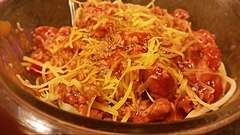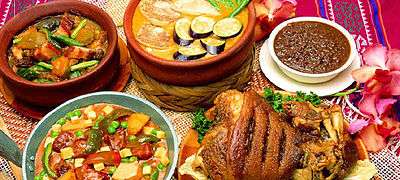Filipino spaghetti
Filipino spaghetti, also known as sweet spaghetti, is a Filipino adaptation of the Italian spaghetti with Bolognese sauce. It has a distinctively sweet sauce, usually made from tomato sauce sweetened with brown sugar or banana ketchup. It is typically topped with sliced hotdogs or smoked longganisa sausages, giniling (ground meat), and grated cheese. It is regarded as a comfort food in Philippine cuisine. It is typically served in almost any special occasion, especially on children's birthdays.[1][2][3]
 | |
| Alternative names | Sweet spaghetti |
|---|---|
| Type | Pasta |
| Course | Main dish |
| Place of origin | Philippines |
| Serving temperature | Hot |
| Main ingredients | Spaghetti, tomato sauce, tomato paste, banana ketchup or brown sugar, giniling, hotdogs, cheese |
Origins
The dish is believed to date back to the period between the 1940s and the 1960s. During the American Commonwealth Period, a shortage of tomato supplies in the Second World War forced the local development of the banana ketchup.[1][4][2] Spaghetti with Bolognese sauce was introduced by the Americans and was tweaked to suit the local Filipino predilection for sweet dishes.[5]
Description

Filipino spaghetti is relatively cheap and easy to make, which is part of the reason for its popularity. First, minced garlic and onions are sautéed in oil in a large pan until they caramelize. The giniling (ground meat) is added and cooked until it is brown. The sliced hotdogs are then added, though it can be replaced with other processed meat like smoked longganisa sausages, ham, Vienna sausages, meatballs, luncheon meat, or even spam or corned beef.[6][7] It is cooked further for a few minutes before the tomato sauce and tomato paste mixture is poured into the pan. Beef stock, mushroom soup, or evaporated milk may also be added.[5] This is sweetened with a bit of banana ketchup or brown sugar, and spiced to taste with salt and black pepper.[8] Other ways to sweeten it include using condensed milk, syrup, or even carbonated soft drinks.[9][10] It is boiled until it reduces to the right consistency.[8] Some people use store-bought spaghetti sauce as the base for convenience, which in the Philippines, may already be sold in Filipino-style flavors.[11][7]
The spaghetti pasta are almost always store-bought. They are cooked usually to al dente consistency. They may be added directly to the sauce and pre-mixed, or served separately with a large amount of sauce poured over them.[11] Grated or cubed cheese (usually cheddar) is added before serving, though sometimes the cheese is infused in the sauce or melted over the pasta.[4][6]
Other ingredients that may be added to the sauce include finely minced red and green bell peppers and carrots.[8][11]
Cultural significance
The Filipino version is often regarded with alarm by Italian spaghetti purists.[2] However, it has great cultural significance for Filipinos as a comfort food.[2] It is almost always served at special occasions, especially on children's birthdays. As such, most Filipinos attach a nostalgic fondness to the dish.[3][4][7]
Filipino spaghetti is a unique offering of fast food chains in the Philippines.[2] It is part of the regular menu of the Philippine branches of Jollibee, McDonald's, and KFC, among others.[2]
See also
- Barbecue spaghetti
- Cincinnati chili, another example of a fusion-cuisine spaghetti dish
- Embutido
- Menudo (stew)
- Naporitan, a similar dish from Japan
- Hawaiian pizza
- Sopas
- SpaghettiOs
- Macaroni salad
- Pancit
References
- Halpern, Sue; McKibben, Bill (May 2015). "Filipino Cuisine Was Asian Fusion Before "Asian Fusion" Existed". Smithsonian Magazine. Smithsonian Institution. Retrieved 16 December 2018.
- Estrella, Serna (30 July 2014). "The Origins of Sweet Spaghetti: A Closer Look at the Filipino Sweet Tooth". Pepper.ph. Retrieved 16 December 2018.
- "Filipino-style Spaghetti". Kawaling Pinoy. Retrieved 16 December 2018.
- "The Origin of the Filipino Style Spaghetti". Juan Carlo. Retrieved 16 December 2018.
- "How to make Sweet Filipino Spaghetti with Meat Sauce". Asian in America. Retrieved 16 December 2018.
- "Filipino Sweet-Style Spaghetti". Spoonful of Butter. Retrieved 16 December 2018.
- Merano, Vanjo. "Filipino Spaghetti Recipe". Panlasang Pinoy. Retrieved 16 December 2018.
- Lee, Sue (1 April 2017). "Sweet and tangy Filipino spaghetti". Pacific Daily News. Retrieved 16 December 2018.
- "Spaghetti with Condensed Milk". Panlasang Pinoy Meaty Recipes. Retrieved 17 December 2018.
- "Just Like Jollibee Spaghetti Recipe". Pinoy Thinking. Retrieved 17 December 2018.
- "Filipino Spaghetti". Pinch of Yum. Retrieved 16 December 2018.
